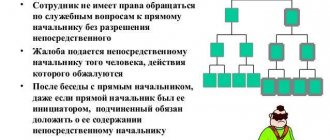Free legal consultation by phone:
8
Any large company must have a motivational and incentive system for employees in order to achieve the main goals of the company and increase overall income. This system is a series of specific incentives that increase the performance of qualified employees.
There are different theories of motivational systems that apply to a specific type of enterprise. In order to effectively achieve the main goals in the organization, it is necessary to organize a unified set of incentives, taking into account all existing theories. This article will help you learn more about this issue.
Contents of the main theories of personnel motivation
Motivation theories in human resource management have a common goal, which is to explain human behavior under different circumstances. In addition, they contain key factors that force a person to perform quality work. The motivational process itself is very complex; in order to describe it, there are different ways that are enshrined in basic theories. The fundamental concepts are:
- Traditional method (it contains a model of blame and reward for material incentive);
- Content-based (encompasses the internal needs of a person);
- Process method (it includes an analysis and description of the behavior of team members in a certain process. In the course of studying certain actions, one can understand the original motive).
All the indicated methods can be combined into a single modern complex, the functions of which will be aimed at properly stimulating all employees.
Content theories of personnel motivation
An example of a meaningful method was proposed by Douglas McGregor, who is a professor at the University of Michigan. His work is based on two models of human behavior, which are designated as X and Y.
X is based on a concept that characterizes the working class as lazy, uninitiated and unscrupulous employees. Workers of Theory X always shift their own responsibilities to others, do only what will be more profitable for them, and never take responsibility for themselves. With this model, the following actions can serve as staff motivation:
- Forced labor;
- Material compensation.
For such workers, only a strict type of control over the performance of duties is acceptable, since with an uncontrolled process, they lose the desire and desire to do the work. For effective influence, it is best to choose punishment.
Model Y contains the opposite type of workers. In this case, the employee is characterized as active, proactive, creative and responsible. He strives to move up the career ladder and gets positive emotions from work. The main type of incentive for such employees is the opportunity for rapid career growth.
Modern theories of personnel motivation
Theories of personnel motivation used in an organization should include not only material, but also social factors. The modern method of incentives states that monetary incentive is not the most important thing in the process of motivating staff; it is also important to influence the employee socially. Every employee wants to work in a friendly atmosphere and have a respectful relationship with their manager. The principles of modern teaching include:
- Stimulating employees through social benefits;
- High-quality performance of work duties occurs with the help of guaranteed incentives, such as decent earnings, career opportunities, comfortable relationships with the team and management.
Modern teachings are created according to the basic models of employee motivation; a set of procedural and substantive methods is included in a unified system of modern incentives.
Process theories of personnel motivation
Motivation of personnel from the perspective of procedural teachings is obtaining the desired result during a certain process. Of great interest is the concept of expectancy, which evaluates the main consequences after performing a certain action. This teaching includes several elements such as:
- Element of expectation (the incentive is that by performing certain tasks, you can achieve the desired result);
- Valence element (positive and negative results in accordance with action and inaction);
- An element of instrumentality (the understanding that there is a set of results that lead to the main goal).
Also included in the procedural method is a work on staging, authored by E. Locke. The essence of the theory presented is that the purpose of the organization should be the main goal of the personnel.
David McClelland's theory of acquired needs
Another very interesting model, based on the study of secondary needs not related to physiological ones. David McClelland identified the following types of human needs that significantly influence employee behavior:
- Achievement Needs
The employee's achievement of ways of working that would be more effective than the previous time. To achieve goals at a higher level, employees want to take more effective actions, improving their work.
There are people for whom this subconscious desire prevails. They are ready to take on work with an element of challenge. They need work that gives a clear, concrete result.
In order to interest such individuals in their work, they need to be presented with very material demands in the area of increasing the efficiency of the ways in which they achieve results.
- Needs for participation (friendly relations with others)
As a rule, for employees with this prevailing need, other people’s opinions about themselves, approval, and support are very important. The status they have in the eyes of their colleagues is important to them.
Typically, these employees are sent to activities related to the provision of services, where communication and communication with clients occurs.
- Needs for power
An important type of human need. The essence is to control the resources flowing around these workers.
The main task of people of this type is to influence colleagues, take additional responsibility for them, etc.
McClelland identified 2 groups of people with needs for power. In the first, people want to rule for the sake of power itself. In the second cluster are employees who need this influence to perform tasks better. It is they, in his opinion, who should be appointed to leadership positions.
Types of staff motivation
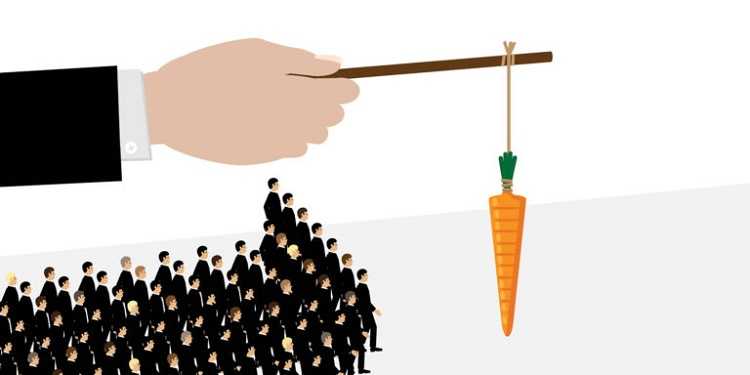
The first type of motivation is direct. This is when an employee has a strong belief that they will receive a reward for their hard work. This type of motivation, in turn, is divided into:
- material incentives for employees (bonuses, vouchers, cash awards, salary increases);
- non-material motivation (certificates, recognition, gifts, memorabilia, improved working conditions).
The second type is indirect. The enterprise takes measures aimed at improving the qualifications of employees and their motivation. Thanks to this method, the zeal for work is renewed, the employee begins to receive satisfaction from completed tasks. The sense of responsibility for one’s work becomes higher and the need for control by management decreases. The program of events varies depending on the field and direction of the enterprise.
The third type is social. A person must understand that he is part of a large team, necessary for the successful functioning of the entire corporation, part of the team. Afraid of disappointing colleagues, partners and management, he will try to fulfill his duties as efficiently as possible.
The fourth type is psychological. The atmosphere within the team, in the workroom, as well as interaction with all elements of the position and work should be at a level of calm and relaxation. A person must want to work, he must like his employment, he must have an interest in work in this particular area. All this will give psychological satisfaction.
The fifth type is labor. Self-realization plays a key role here.
The sixth type is career. For the sake of promotion, a person will try to work harder.
The seventh type is gender. The desire to surpass someone in success, boasting to friends and family, as well as colleagues, can force an employee to do a better job.
The eighth type is educational. The desire to gain new knowledge and skills plays a key role here.
Methods can be negative and encouraging.
Negative:
- deprivation of bonus;
- reduction in wages.
Incentives:
- privileges;
- bonuses in the absence of sick leave or other absences from work;
- bonus payments;
- additional vacation days or days off;
- gifts or certificates for services and goods.
Types of personnel motivation in an organization
There are two types of motivation - internal and external. The organization needs to understand that employees are not clones, but people with different character traits. Therefore, effectively motivating your employees will require a deeper understanding of the different types and methods of motivation.
By understanding this, you can better classify your employees and apply the right type of motivation to increase employee engagement and satisfaction. Some employees respond better to intrinsic motivation, while others may respond better to extrinsic motivation.
Intrinsic motivation
Intrinsic motivation means that a person is motivated from within. He has a desire to perform well in the workplace because the results align with his belief system.
A person's deeply held beliefs are usually the strongest motivational factors. Such individuals exhibit common qualities such as acceptance, curiosity, honor, and a desire to succeed.
Research has shown that praise increases intrinsic motivation, as does positive feedback from employees. But all this must be done in moderation. If you overdo any of these, there is a high chance that the person will lose motivation.
This is well observed in children and is used as an example here - if children are overrated for the little things they have to do on a daily basis, their motivation levels decrease.
So if you are a manager or leader, please be intentional about your feedback or praise. Make sure it's empowering and your employees understand your expectations.
Extrinsic motivation
Extrinsic motivation means that a person's motivation is stimulated by external factors - rewards and recognition. Some people may never get intrinsic motivation and only extrinsic motivation will work for them to complete tasks.
Research shows that extrinsic rewards can sometimes stimulate a person's desire to learn a new set of skills. Rewards such as bonuses, perks, rewards, etc. can motivate people or provide real feedback.
But you also need to be careful with external rewards! Too much of anything can be detrimental, and as a manager or leader, you must be clear about the extent to which you are going to motivate your employees to achieve the organization's goals.
Maslow's theory of motivation in brief and pyramid of needs
All human needs are based on physiological ones - those that are directly related to survival: food, water, air, sex, etc.
At the second level is the need for security and confidence in the future. Here we are talking about the fact that a person seeks protection from the dangers of the external environment.
At the next level of the pyramid are social needs (involvement). These are people’s feelings that arise in relation to the social whole: the environment, close people who would support it.
Further, on the fourth hierarchical link are the needs for respect and social recognition. People want to be valued, praised for their achievements, competence, and respected by people in authority.
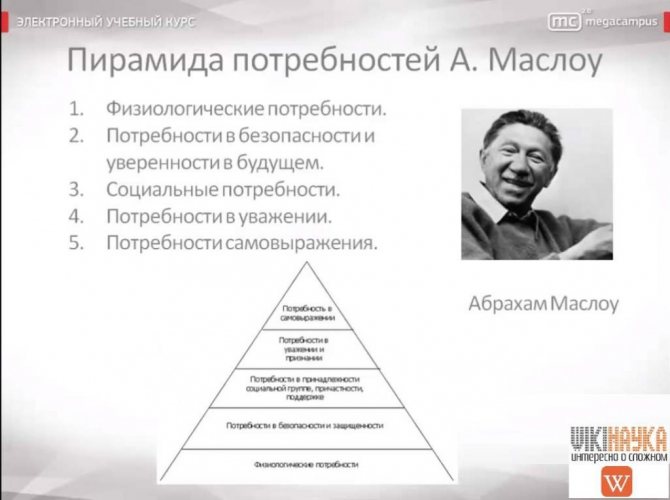
The highest level is the need for self-expression and self-realization. It is necessary for a person to realize his personal potential.
Personnel motivation system: concept, development
This is a set of activities aimed at the internal values and needs of subordinates, stimulating not only work in general, but also, above all, diligence, initiative and the desire to work. And also to achieve the goals set in their activities, to improve their professional level, and to increase the overall efficiency of the enterprise. The staff motivation system consists of two components.
Compensation system
It includes the following components:
- Remuneration.
- Disability payments.
- Employee insurance.
- Overtime pay.
- Compensation for loss of place.
- Payment equivalent to the income received.
Not a compensation system
It includes the following methods:
- Improving mental state and mood, various sets of programs for advanced training, intelligence, erudition, and self-improvement.
- Activities aimed at raising self-esteem and self-esteem, and satisfaction from one’s work.
- Uniting and encouraging the team through cooperatives.
- Setting goals and objectives.
- Control over their implementation.
- Offer to take a leadership position.
These methods do not involve any payments.
Practical use of content theories
Today, the management of most enterprises accepts the importance of the human factor in increasing productivity. In practice, motivation theories are implemented through personnel management
Use in management
In management today, the creation of open and trusting relationships with subordinates comes to the fore. Competent managers try to create self-organizing teams, transferring some management functions to the employees themselves.
However, in general, Russian management needs to study the experience of successful use of motivational theories in the management of foreign companies and follow it.
To be fair, it should be noted that in Russia managers partially use substantive concepts of motivation, but there is no system for their application. So, for example, there are Russian companies whose management is impressed by the theory of D. McGregor, but they use only the provisions of theory X, ignoring the points of theory Y. Unilateral application of the theory does not produce results - subordinates in such companies are passive. In the abstracts of psychologists, this approach was called “staff prison.”
Thus, meaningful theories of motivation can increase labor productivity in an enterprise. To do this, management needs to choose the right motivating factors. Material incentives play an important role in shaping an employee’s desire to work with full dedication, but in the absence of other motivating factors, it does not give the desired result.

Effective Application of Motivational Theories
Content theories of motivation
The most famous theories of the content class include the theories of A. Maslow, F. Herzberg, D. McClelland and F. Taylor. They are mainly focused on two groups of needs:
Need help creating a study plan? Specify a topic and receive a response in 15 minutes get help
- primary (related to physiological factors);
- secondary (psychological).
The most famous is Abraham Maslow's theory of motivation, which is reflected in the Pyramid of Needs (Figure 2).
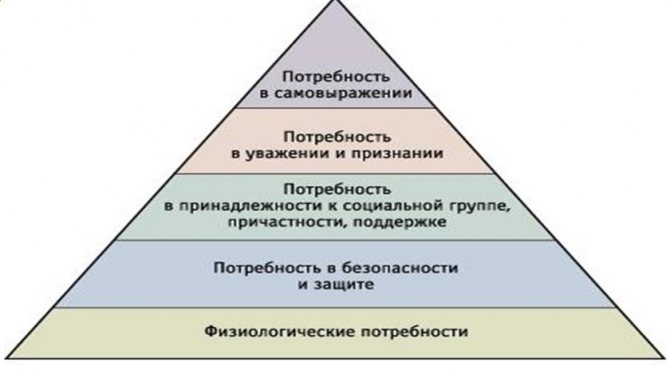
Figure 2. A. Maslow's pyramid of needs. Author24 - online exchange of student work
In accordance with the theory of A. Maslow, the fundamental needs that require priority satisfaction for a person are physiological needs, the satisfaction of which is necessary for survival. Following them comes the turn of other needs, which also have their own hierarchy: the need for security, the needs of a social nature, the need for recognition and respect, and, finally, the need for self-expression. In order to motivate an employee, the employer must provide him with the opportunity to satisfy his most important needs through a course of action that contributes to the achievement of the goals of the entire organization. However, in practice, the hierarchy of needs is not so clear and is not suitable for building a motivation system in an enterprise.
F. Herzberg's model is based on two groups of factors: hygiene and motivation factors. The former are directly related to the environment in which the work is carried out (working conditions, wages, company policy, interpersonal relationships in the team, degree of control, etc.), and the latter - in which the work is carried out (working conditions, wages, company policy, interpersonal relationships in a team, degree of control, etc.). Hygiene factors in themselves are not motivators, but failure to provide them leads to dissatisfaction among employees.
McClelland's theory of needs places its main emphasis on the needs of higher levels. These needs include power, success, and belonging.
F. Taylor's motivational theory, on the contrary, places emphasis on satisfying the instinctive needs of the physiological level, and considers work rationing and hourly wages, coercion and rules describing the procedure for performing assigned tasks to be factors that ensure employees' interest in highly productive work.
Non-material motivation
There are many more types of non-material motivation. These include:
- Praise from the administration of the organization. If the manager notices not only the mistakes of his subordinates, but also the successfully completed work, and does not skimp on praise, the employees strive not to disappoint management in the future. Therefore, institutions still use honor boards today as a form of reward for conscientious employees.
- Career advancement. Every subordinate knows that for the high-quality performance of his job duties he is guaranteed a promotion. This increases his status among colleagues and promotes career growth. However, moderation must be observed, otherwise this will lead to competition within the team, and teamwork will have to be forgotten.
- Advanced training at the expense of the organization. Training will improve the professional level of staff and will be an excellent way to motivate each employee to work better.
- Creating a friendly, warm atmosphere. Lack of cohesion among colleagues negatively affects the work of the organization as a whole, while a friendly team can easily cope with the most difficult issues.
- Creating a company image and taking care of it. An organization that has gained popularity in the market attracts not only potential clients, but also makes working in it prestigious. This means that this is an excellent motivation.
- Organization of joint leisure. Teamwork is not only joint work, but also relaxation. Field trips, sports competitions, joint visits to the theater, museum, and exhibitions can unite the entire team, and each employee will value their workplace. This staff motivation is based on the principle: those who rest well work well.
- Having feedback is a great motivation for employees. If every subordinate knows that his opinion is not indifferent to management, and is not afraid to offer ideas for modernizing work, this has a positive effect on the entire enterprise.
The choice of material and non-material methods of motivating staff remains with the manager. Only the director has the right to decide which incentive methods will be most effective in today’s market conditions and will help achieve maximum staff productivity.
Principles of Motivation
There is no single rule or way to motivate staff, but there are principles for developing your own effective method:
1.
Motivation that makes the employee feel important and needed will be effective. Such encouragement evokes respect and good envy among colleagues. However, you should know when to stop everything, otherwise the loss of awards will lead to the moral disqualification of the employee.
2.
Unforeseen one-time incentives work more successfully than systemic incentives (monthly bonuses for high-quality work). People quickly get used to systematic methods and consider them part of the norm.
3.
Praise works better than punishment.
4.
Management's response (positive or negative) must be immediate. Thus, the subordinate feels significant: the boss is not indifferent to his achievements or failures.
5.
An intermediate result is also a result! Incentivizing employees for small successes will speed up the achievement of the main goal.
Adams' theory of justice
Another fairly common process theory of motivation is the equity theory or equality theory. It was proposed in 1963 by American psychologist John Stacy Adams
.
Adams' Equity Theory states that people always subjectively evaluate the relationship between the reward received and the effort expended to achieve it, and also compare it with the ratio of other workers performing similar work.
That is, people often tend to believe that they work hard and get little, while their colleagues work less and get more! If a person thinks so, then he feels injustice.
John Adams identified six possible employee reactions to injustice:
- Reducing effort (“I don’t intend to work hard for such pennies!”);
- An attempt to achieve an increase in remuneration for your work (“Boss, you will be lost without me! I want an increase in salary and a personal account with a secretary!”);
- Decreased self-esteem (“I get paid so little because I’m a loser...”);
- An attempt to influence the salary or workload of other employees (“I do all the work alone! Then let Vasya take on additional responsibilities or not receive a bonus!”);
- Choosing another object for comparison (“Well, of course, Pyotr Vasilyevich gets more than me, he’s the boss’s son, after all. But I get more than Uncle Kolya”);
- An attempt to move to another department, workshop or organization (“I’m not valued here, I’ll go to competitors!”).
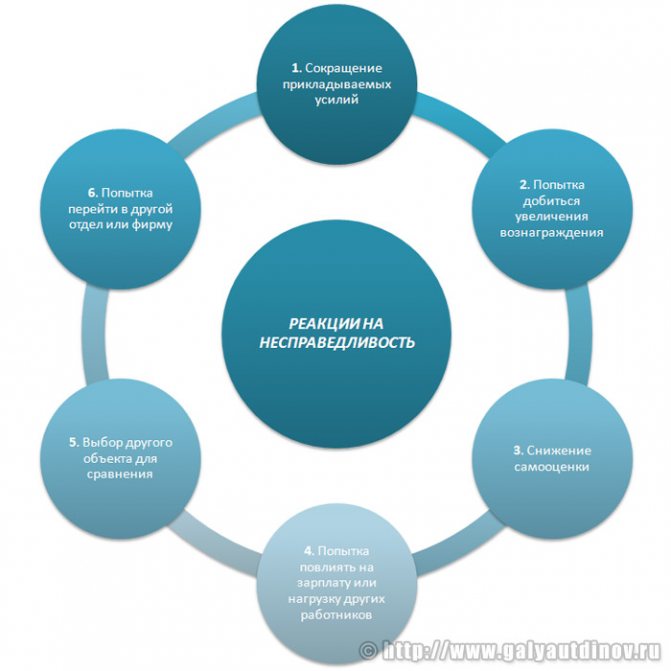
and depend on the individual characteristics of the employee. Perceptions of fairness may differ among employees, and the ratio of effort/return they perceive does not always correspond to reality. Therefore, the manager must monitor the occurrence of such contradictions and eliminate them in a timely manner.
Examples of incentives
A completely different approach is already noted here. For example:
- Anyone who does not fulfill the implementation plan this month will be deprived of the bonus.
- You will not leave your workplace until you have completed your annual report.
- If you don’t like the working conditions, you can put your resignation letter on the table, there are no irreplaceable people.
The examples show that motivating and stimulating staff is similar to the popular “carrot and stick” method. This means that motivation awakens the employee’s inner desire to work, and stimulation forces him to work if there is no such desire.
But it’s still not worth focusing on stimulation, because most people hate their jobs for this very reason and are forced to stay because there is no way out. In some cases, it can be used if a subordinate copes with his direct responsibilities very poorly.
Often employers resort to stimulation because it does not require costs and is simpler. But this method leaves workers in a state of stress. The consequence of this is poor work performance and frequent layoffs, which leads to staff turnover, and this is a big disadvantage for the enterprise.
Therefore, it is necessary to combine these methods, but focus on motivation. Then the manager will be able to create an efficiently working, well-coordinated team, whose employees will fight in conditions of healthy competition.
Theoretical foundations of motivation in management
Definition 1
Motivation in management is a purposeful process of activating the activities of employees, aimed at encouraging them to work by satisfying their needs. It is based on the motivation of a person to action.
Today, the motivational management of modern organizations is based on various theories of motivation. Over the entire period of studying the issues of motivation in management, scientists and practitioners have developed many different approaches to determining the main factors that motivate a person to highly effective work. Among the outdated motivation systems is the “carrot and stick method”, which has been especially popular for many centuries. Modern motivational theories have been divided into 2 main groups. They are presented in general form in Figure 1.
Finished works on a similar topic
- Course work Theories of motivation in management 490 rub.
- Abstract Theories of motivation in management 220 rub.
- Test work Theories of motivation in management 240 rub.
Receive completed work or specialist advice on your educational project Find out the cost

Figure 1. Modern grouping theory of motivation in management. Author24 - online exchange of student work
The basis of substantive theories of motivation is the definition of needs and identification of personal motives that motivate people to certain actions. Theories of a procedural nature, without challenging human actions based on motives in order to satisfy needs, focus on the behavior of people, taking into account their knowledge and upbringing.
Each of the groups presented includes many different theories. Let's look at the most famous of them in more detail.
McClelland's theory
McClelland's theory differs from Maslow's theory, which focuses on satisfying existing needs rather than creating or developing them.
McClelland identified three basic needs:
- Achievement: The need to achieve and demonstrate competence or mastery.
- Belonging: The need for love, belonging and relatedness.
- Power: the need to control one's work or the work of others.
McClelland argues that we all have these three needs in one form or another, regardless of age, gender, race or cultural background. Each person's needs are learned through their life experiences and are not innate. This is why this theory is sometimes called the learned needs theory.
For example, while some people may desire power, not everyone wants to be powerful at any cost. Likewise, while some people avoid attention at all costs, many still want a little praise. Most people do not exist at the extremes of every need.
| Need for achievement | Need for power | Need to belong |
| Perform difficult tasks, set records, or do something that has not been done before. | Desire to be responsible for others. | Follow the social norms of the organization for fear of rejection. |
| Results must be controlled and based on effort, not external factors. | The joy of victories and competitions. | Enjoy collaboration, but dislike competitive situations. |
| Receive feedback on your work. | Enjoying status and motivating others. | Avoid risky situations and uncertainty. |
| Avoid high and low risk situations. Low-risk situations provide little sense of achievement, and high-risk situations are too much out of control. | Using only winning arguments. | The desire to belong to a group. |
How to use in practice
Determine the needs of each team member
If you don't have much experience identifying employee personality types or simply don't know your team very well, you can ask them to rate the importance of each need in McClelland's theory for themselves. Decide how you will adjust your style and approach to each team member. . The main points in McClelland's theory:
The main points in McClelland's theory:
- The Three Needs Theory can help you identify the key motivators driving your employees and then use that information to help get the most out of each team member.
- You can do this by changing the way you give feedback, your goals, your leadership style, and the way you try to motivate them.
All the main theories of work motivation are clear and concise
The process of motivation is complex and ambiguous. There are different approaches to describing the process of emergence and implementation of employee needs.
These approaches are reflected in various theories of motivation.
Each of these techniques has something to offer managers, and their different elements complement each other in many ways. Managers should be able to identify the needs, abilities and goals of employees, and also take into account differences in preferences for the type of reward.
Conventionally, all theories of motivation can be divided into substantive and procedural. Content theories
focus on the internal needs of the individual that give impetus, direct, support and stop this behavior.
Process theories
provide a description and analysis of how behavior is initiated, directed, maintained, and terminated.
There are three main types of work motivation:
- Material.
- Social (moral).
- Organizational (administrative).
Among the motives of work, decisive importance is given to motives associated with material interest, since they influence the choice of profession, place of work, and determine the attitude towards work.
Material motivation
is implemented through a wage system, a system of differentiated accounting for the types and effectiveness of labor, a system for selling money received for labor (development of the sphere of spending earned labor income). Additional incentives include payment of transportation costs, subsidies for food, payment of educational expenses, medical care, tourist trips on weekends and during vacations, payment of life insurance costs for employees and their dependents, accident insurance, etc.
Social or moral motivation
is based on a person’s moral values, the employee’s awareness of his work as a certain duty to society, and an understanding of the value and usefulness of this work. This category also includes incentives associated with the creative richness and content of work, its relatively favorable conditions, relationships in the work team, relationships between an employee and his manager, the possibility of professional growth, self-improvement and self-expression.
Organizational (administrative) motivation
relies on the right of the administration (employer) enshrined in law to demand that employees comply with accepted labor rules. The basis of this type of motivation is labor discipline, and its result is disciplinary liability, which provides for measures of influence on the employee for improper performance of his duties.
Characteristics of theories of work motivation
| Name of theory, authors | Basic concept |
| Classical theory of scientific management (Frederick Taylor, Frank Gilbreath, Harry Grant, etc.) | Employees of an organization are significantly interested in work if material reward is closely related to the results of their work. Monetary incentives are the only basis for high production performance |
| Theories X and Y (Douglas McGregor) | Some people don't like to work “innately”, so they can only work well under constant supervision and coercion (Theory X). Others themselves motivate the need to work and find inner satisfaction in work - however, if the necessary conditions are created for this (Theory Y) |
| Theory Z (William Ouchi) | Caring for each employee of the organization, the quality of work life, involving employees in group decision-making - these are the prerequisites for unlocking their potential |
| Human Relations Theory (Frederick J. Roethlisberger, Elton Mayo, Rensis Likert) | The key factor of motivation is the leader. It is the manager who must make the employee feel that he is a member of the team and occupies an important place in it. At the same time, a democratic leadership style is professed |
| Hierarchy of needs theory (Abraham Maslow) | There are five levels in the hierarchy of needs: 1) physiological needs; 2) the need for security (both physical and economic); 3) the need for love, belonging (social needs); 4) the need for respect, recognition; 5) the need for self-expression. If the needs of lower levels are satisfied, then to motivate the employee to work, the next, higher level of needs must be activated. |
| Factor "2" (Frederick Herzberg) | In the two-factor model of work motivation, two large categories are distinguished: 1) hygiene factors; 2) motivators. Hygiene factors, support factors (company policy and management, working conditions, wages, interpersonal relationships with the manager, the degree of direct control over work) are preventive in nature and can cause a feeling of dissatisfaction in the employee, but they are not motivating factors. Motivators include higher-order needs, such as production achievements, social recognition, work itself, responsibility and career opportunities. The task of management is to eliminate irritants (satisfy basic needs) and use motivators (satisfy higher needs) |
| Learned Needs Theory (David McLelland) | Three dominant needs are identified: 1) involvement (affiliation); 2) power; 3) success. By establishing reward patterns (recognition, promotion, achieving a certain social position, etc.) and reinforcing the expectation that rewards will result from better behavior or performance, motivation for more productive and high-quality work can be increased. |
| ERG Theory (Clayton Alderfer) | There are three groups of needs: 1) existence needs (survival, physical well-being, wages) - Existence Needs; 2) needs for connections (interpersonal connections, establishing contacts, respect, personality assessment) - Relatedness Needs; 3) needs for growth (internal desire for the development of creative potential, for self-realization) - Growth Needs. According to ERG theory, rigid hierarchy is rejected |
| Goal Setting Theory (Edwin A. Loke) | The conscious needs of the employee determine his actions. The goal will influence the effort exerted and influence the choice of behavior |
| Behavior change theory, reinforcement theory (Burres Frederick Skinner) | Behavior can be controlled, refined and changed thanks to certain changes in the system of rewards and punishments |
| The theory of preferences and expectations VIE (Victor Vroom) | The motivation of an employee's behavior is determined by three factors: 1) the strength of confidence that specific actions will lead to a specific result; 2) the strength of confidence that a specific result will lead to a specific reward; 3) attractiveness or acceptability of the reward. The strength of motivation is a function of the sum of the valences of the results (including instrumentality) multiplied by the expectation, and valence (V - Valence) is the stability of the employee’s preferences regarding a specific result (Y = +1, 0, –1). Instrumentality or significance (I - Instrumentality) is the standard of subjective assessment of the employee: whether the initial action leads or does not lead to achieving the goal (–1 < I < +1). Expectation (E - Expectancy) is the probability of achieving a certain result (0 < E < 1) |
| Theory of justice, equality or equity (J. Stacy Adams) | The main source of work motivation is the impartiality or fairness that the employee expects to encounter in the work team. If the ratio of “output-output” that an employee receives (remuneration) to “input-input” in the performance of work turns out to be unequal from his point of view, similar to the ratio of other workers, then this is a sign of injustice and, accordingly, a prerequisite for the emergence of psychological stress. In accordance with this theory, the adequacy of remuneration is assessed by the ratio of “input” and “output” |
| Integrated Process Theory of Motivation (Lyman Porter, Edward Lawler) | Includes elements of expectancy theory and equity theory. Based on five variables: 1) effort expended; 2) perception, expectation; 3) the results obtained; 4) remuneration; 5) degree of satisfaction. Key takeaway: productive work leads to satisfaction |
| The theory of “mathematical” expectation (John Atkinson, N. Fizer) | An employee’s motivation to implement a certain task is a function whose components are the strength of the motive for productive work, the subjective probability (expectation) of success and the attractiveness of the task (valence) |
| Attribution Theory (Fritz Heider) | Internal forces (personal qualities, such as abilities, efforts, fatigue) and external forces (properties of the environment), complementing each other, determine the behavior of the employee. Attribution theory is a theory about how people explain the behavior of others: whether they attribute the reason for actions to the person's internal dispositions (character traits, motives, and attitudes) or to external situations |
| Control Theory (William Glasser) | It is associated with the employee’s feelings, namely how much control he has over his production activities. It is believed that job satisfaction depends on conscious control |
| Representation Theory (Michelle Jensen, William Mexing) | The key point of the theory is that the interests of the owners of an organization and its employees may differ, and this discrepancy can be reduced by establishing appropriate rewards |
| Theory by John P. Campbell, Marvin D. Dunnett, Edward E. Lawler, and Carl E. Wake Jr. | People are motivated by determining how urgent their needs and expectations are, how much their actions motivate them to achieve their goals, and what results others have achieved under similar circumstances. |
| Herbert Kaufman theory | Organizational and occupational specialization can develop workers' desire and ability to meet organizational goals |
| Robert Prestas theory | A threefold classification of organizational adaptation models is proposed: 1) “moving upward” - those who understand and accept all the values of the organization; 2) “indifferent” - those who reject such values and find personal satisfaction outside of work; 3) “ambivalent” - those who want to enjoy the benefits that the organization provides, but do not meet its requirements |
| Theory of Werner Siegert and Lucia Lang | The criterion for optimal motivation and rewards is ensuring mutual satisfaction of the organization (management) and the individual. Attention is focused on the emotional side of production problems |
| V. Arnold's theory | The effectiveness of motivation is determined by the direction and quality of efforts, and not by their summation. The productivity of motivation is enhanced by the energy of purposeful behavior, the advancement of the individual towards actions that are effective for the organization |
| Work Redesign Concept (J. Hackman and Greg Oldham) | Work motivation should be measured using the following five characteristics: 1) variety of work; 2) completeness of the work; 3) the significance of the work; 4) autonomy at work; 5) feedback (the ability to evaluate the results of one’s own efforts) |
| Thomas Stewart theory | Working with personnel requires the creation of comprehensive motivational programs. At the same time, employees of the organization receive into their hands four symbols of liberation: information, knowledge, power and reward. |
Natalya Fedorova
Elitarium
Process theories of motivation
V. Vroom's theory of expectations, based on the close relationship between labor costs and its results, the level of remuneration received and satisfaction with it, has become widely known among process theories. According to his theory, employee satisfaction and motivation are directly dependent on the degree to which the expected reward corresponds to the results of work. If the employee does not have an understanding of the clear connection between the achieved results and the desired reward, his motivation will weaken, and he will strive to minimize the costs of his own labor.
Equity theory, complementing expectancy theory, postulates that people subjectively determine the ratio of reward received to effort expended and then relate it to the rewards of other people performing similar work. The use of this theory in practice can be successful if it is possible to establish a fair reward system and explain its possibilities to employees.
Elements of the two theories described above are embodied in the Porter-Lawler model, which includes five variables. These include:
- effort expended to obtain a certain result;
- perception;
- results obtained during the work process;
- remuneration;
- degree of satisfaction.
According to the presented model, the results achieved during the work process are directly dependent on the efforts made by the employee, his abilities and characteristics, as well as his awareness of his role in the organization. The level of effort exerted, in turn, is determined by the value of the reward and the degree of confidence employees have in receiving a certain reward. Thus, employees of the organization satisfy their own needs by receiving rewards for the results achieved.
Note 1
A modern trend in theories of personnel motivation is also the concept of participatory management. It is based on the postulate that there is a relationship between employee satisfaction with their work and their interest in taking part in various intra-company activities.
Modern theories of personnel motivation
Currently, we can distinguish 3 main groups of theories of motivation: initial, substantive, procedural.
Initial theories of motivation are based on the use of simple coercive incentives, material and moral incentives for workers.
The theory of “carrots” and “sticks” (positive and negative motivation) is widely known, according to which employees clearly know what they can be rewarded for and what they can be punished for.
The main tenet of the original theories of motivation is the use of positive or negative incentives depending on the results of job evaluation and employee behavior.
Example: The Regulations on material incentives for employees of an organization provide a list of grounds and forms of rewards and punishments for employees for performance results.
A development of the “carrot” and “stick” theory is the “X” and “Y” theory of D. McGregor. From the point of view of motivation, two groups of employees have been identified: employees of type “X” and employees of type “Y”, who have different needs and motives (Table 1).
According to the theory of “X” and “Y”, when motivating employees, it is necessary to take into account the state of their level of consciousness. Managers should strive to develop a group, if it is not sufficiently motivated, from state "X" to state "Y".
Theory “Y” was developed in the works of German scientists W. Siegert and L. Lang, who noted the importance of awareness, freedom of action and the significance of the employee’s workplace for motivating his work activity.
The theory of “X” and “Y” was further developed in the works of V. Ouchi, who substantiated the importance of the team in motivation. The main provisions of the “Z” theory of motivation by V. Ouchi are the provisions on the combination of social and biological needs in the motives of employees and their preference to work in a group and apply the group decision-making method. Thus, a good employee prefers to work in a group and have stable performance goals for the long term.
Workers described by theories “X”, “Y” and “Z” form different groups of people and have different motives of behavior and incentives to work.
As a rule, all types of workers are represented in an organization, and the application of one or another motivation concept is determined by the proportion of workers of a particular type in the group.
Thus, the application of the original theories of motivation in practice makes it possible to ensure high-quality performance of job duties by an employee, but does not contribute to the formation of a person’s internal motivation for effective work.
Content theories of motivation are based on the identification of needs that cause people to act in a certain way. The most famous are the theories of Maslow A., Alderfer K., McClelland D., Herzberg F. Each of the authors offers its own classification of needs that have the greatest impact on a person’s work activity.
According to substantive theories, management of work motivation consists of identifying the dominant human need and developing measures to satisfy it (Fig. 1).
Maslow's hierarchy of needs theory A. According to this theory, human behavior is determined by needs, which can be divided into five groups and arranged in a strictly hierarchical structure (Fig. 2).

According to A. Maslow, a person is an “eternally wanting creature”: when a lower need is satisfied, a higher one becomes dominant. Consequently, in terms of the power of influence on the employee’s behavior, the dominant needs will be those located directly above only satisfied needs.
However, as practice shows, hierarchical levels are not discrete steps. People tend to start looking for their place in the community long before their safety needs are met or their physiological needs are fully satisfied.
K. Alderfer's theory. Clayton Alderfer grouped human needs into three groups:
- Existence needs;
- Communication needs;
- Growth needs.
The need groups of this theory correlate with the need groups of Maslow A.'s theory. Existence needs include safety needs and physiological needs; group of communication needs - belonging and involvement; growth needs - needs of self-expression.
However, in contrast to Maslow A.'s theory, Alderfer K. believed that movement goes in both directions: upward, if the need of the lower level is not satisfied, and downward, if the need of the higher level is not satisfied. Alderfer K. calls the process of moving up the levels of needs the process of satisfying needs, and the process of moving down – the process of frustration, i.e. defeat in the desire to satisfy the need (Fig. 3).
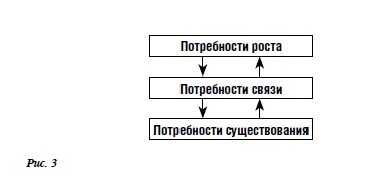
Example: If an organization does not have sufficient funds and capabilities to satisfy a person's growth needs, then, out of frustration, he may turn to communication needs with increased interest. In this case, the organization will be able to provide him with opportunities to satisfy this need, thereby increasing the potential for motivating this person.
McClelland D.'s theory of needs. McClelland D. identifies three needs that have the greatest impact on an employee's performance: power, success, and participation (Table 2).
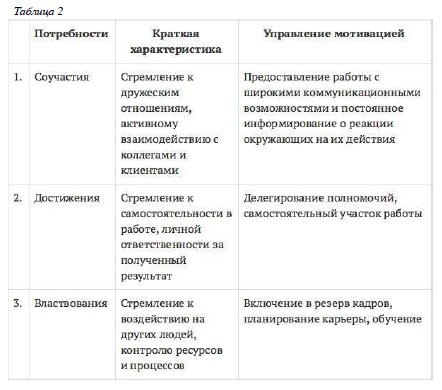
The needs of participation, achievement and power in McClelland D.’s concept are not mutually exclusive: the manifestation of the influence of these needs on human behavior strongly depends on their mutual influence.
Example: If a person is in a leadership position and has a high need for power, then for successful management activities it is desirable that his need for complicity be relatively weakly expressed.
Herzberg's theory of motivation. In the literature, F. Herzberg's theory of motivation is often called the theory of motivational hygiene or the theory of “social man”. Herzberg F. identified two groups of incentives for intensifying a person’s work activity: hygienic, motivational (Table 3).
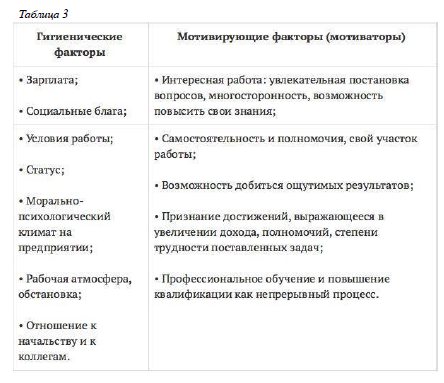
Hygiene motives are motives that create the mood for work; they can be both motivators and demotivators of work activity.
Example: A low level of wages is, as a rule, a demotivator of work activity, and wages in accordance with the specific results of a person’s work are a motivator.
The manager's goal is to create conditions so that hygiene factors become motivators of work activity. F. Herzberg considers motivating factors to be those that always contribute to increasing the efficiency of workers.
Consequently, if we eliminate the factors of employee dissatisfaction with the work environment, then it is possible to form the motives of his work activity using factors of job satisfaction.
Did not you find what you were looking for?
Teachers rush to help
Diploma
Tests
Coursework
Abstracts
Table 4 shows the basic principles of enriching the content of work to motivate work activity.
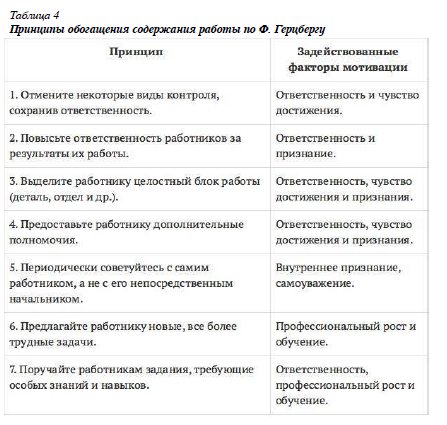
Thus, the application of substantive theories of motivation in practice consists of identifying the dominant need of an employee and developing incentive measures to satisfy it in order to increase the efficiency of work activity.
Process theories of motivation are based on the assumption that an individual's behavior is a function of his perceptions and expectations associated with a particular situation and the possible consequences of his chosen type of behavior.
There are three main procedural theories:
- expectancy theory;
- theory of justice;
- reinforcement theory.
Vroom V.'s expectation theory is based on the position that the more an employee's expectations are met, the more effective his work will be. V. Vroom identifies 3 main expectations of an employee in the labor process: that his labor efforts bring concrete results, according to which he will receive the expected reward (Fig. 5).
It is important to highlight the concept of “valence” as the expected degree of relative satisfaction (dissatisfaction) that arises when receiving a reward. If there is no direct connection between the effort expended and the results achieved, then motivation will weaken.
Example: In practice, for effective motivation, a manager must clearly formulate the employee’s work goals and the expected results that he should receive in the work process; establish a clear relationship between achieved results and rewards; formulate what types of remuneration an employee can expect.
S. Adams' theory of justice. According to equity theory, people subjectively determine the ratio of reward received to effort expended, and then relate it to the rewards of other people doing similar work. If a comparison shows that a colleague received more compensation for the same work, then the employee experiences psychological stress; to restore justice, it is necessary to either change the level of effort expended or change the reward.
Experts note that usually when people believe that they are not being paid extra, they begin to work less intensively. If they feel they are overpaid, they are less likely to change their behavior and activities.
B. Skinner's motivation enhancement theory shows the dependence of employee motivation on their past experience. According to his theory, the presence of incentives causes a certain behavior in a person, depending on the consequences of which it is repeated or not. Repeated repetitions of the same results lead to the formation of a certain behavioral attitude in a person.
Example: A manager must anticipate the psychological impact of the consequences of employees performing the tasks he gives them, and set achievable goals for them, the implementation of which can cause a positive psychological effect in them.
Porter-Lawler model. Porter L. and Lawler E. in their theory of motivation combined elements of the expectancy theory and the theory of justice (Fig. 6).
According to this model, the results achieved depend on the efforts made, abilities and characteristics of a person, as well as on his awareness of his role in the labor process. The level of effort expended, in turn, depends on the value of the reward and the extent to which the person believes that there is a strong connection between the effort expended and the possible reward. Achieving the required level of performance may entail internal rewards (satisfaction from the work performed, a sense of competence and self-esteem) and external rewards (supervisor praise, bonus, promotion).

Satisfaction is the result of external and internal rewards, taking into account their fairness. Without satisfaction there can be no effective work.
Atkinson D.'s theory of work motivation is based on the position that employee behavior is the result of the interaction of individual qualities of a person and the situation of his perception. Every person has two motives - a motive for success (Mu) and a motive to avoid failure (Mn). These motives are quite stable and are formed in the process of learning and work; they manifest a person’s desire for a certain level of need satisfaction.
In addition to personal qualities, a person’s behavior is influenced by two situational variables: the probability of success with which the employee expects to complete his activity (Vu), and the attractiveness of success (the value of the incentive) for the individual (Pu). Moreover, the attractiveness of success is directly related to the probability of success:
Pu = 1 – Wu (1)
Thus, the higher the probability of success, the lower its attractiveness.
The desire for success (Su), which expresses the strength of motivation, can be expressed by the following formula:
According to this formula, the desire for success will be maximum when the probability of success is 0.5, since the product Wu x Pu in this case is maximum. But when determining the desire for success, it is necessary to take into account the motive for success, which is expressed differently among different employees.
Any specific situation activates the motive for success and at the same time the motive that encourages Mn to avoid failure. In this case, the sum of the probability of expecting success Wu and the probability of failure Bn is equal to 1.
According to Atkinson D.'s theory, individuals who are more success-oriented prefer tasks of average complexity, since in this case the degree of risk is lower, although the attractiveness of success is less. At the same time, employees who accept failure for the sake of the high attractiveness of possible achievement of the goal prefer extreme tasks on the principle of “do or die”; such employees belong to the so-called “risky” personality type. It is advisable to entrust the first group of employees with those tasks that absolutely must be completed within the allotted time frame, while the second group of employees is best used when it is necessary to find atypical solutions.
Thus, procedural theories of motivation are aimed at developing such work behavior of an employee that will ensure the effectiveness of his work activity. Process theories of motivation are more universal compared to substantive theories of motivation, but, unfortunately, do not take into account the entire range of human needs.
At the end of the 90s of the twentieth century, the Russian scientist V.I. Gerchikov developed a typological model of personnel motivation (Fig. 7), which takes into account both the motivation and type of labor behavior of the employee.
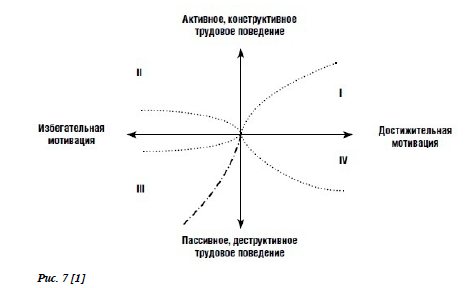
As can be seen from Fig. 7, the author distinguishes between achievement motivation (an employee’s desire to achieve certain goals and receive a reward for this) and avoidance motivation (the desire to avoid punishment for failure to complete assigned tasks or unsatisfactory performance of functions).
In the case of achievement motivation and active work behavior of an employee, the increase in the efficiency of his work activity will be proportional to the degree of satisfaction of motivational expectations (I quadrant). At the same time, if organizational working conditions and the incentive system run counter to the motivational expectations of an employee with an achievement type of motivation, then there is a high probability of his destructive work behavior (IV quadrant).
In the case of avoidance motivation, subject to the employee’s active labor behavior, the increase in the efficiency of his work will be limited by the task (normative value) and the manager’s ability to prove the employee’s guilt in case of failure to complete the task (Quadrant II); with passive labor behavior, the employee can only be expected to “work according to the rules” (Quadrant III).
According to this theory, there are five personality types of workers depending on the type of motivation: instrumental, professional, master's, patriotic (achieving) and lumpen (avoidant).
In order to increase the efficiency of labor activity of different types of workers, it is necessary to select appropriate incentives.
Non-material motivation of personnel
Types of non-material motivation of personnel can be the following:
- Promotion. Both in the horizontal and vertical career ladder. The employee tries to work better than others in order to get the desired promotion;
- Participation in meetings with management;
- Motivational meetings;
- Good atmosphere in the team. A friendly, cohesive team serves as additional motivation for effective labor productivity.
- Employment and a full social package, according to current legislation, are a significant aspect in finding a job, and when getting one - good motivation;
- Cultural and sporting events within the company. As a rule, spending time together for the entire team promotes cohesion and a good working microclimate, and also provides an excellent opportunity for quality rest and relaxation;
- Competitions and competitions;
- Enterprise prestige. Working in a company whose name is on everyone’s lips will also serve as an incentive for productive cooperation;
- Public recognition of employee achievements;
- Congratulations on significant dates for the employee;
- Peer ratings;
- Help with family matters.
Non-material methods of motivation can be divided into individual and collective.
1. Individual ways of motivation:
- empowerment of the employee so that he can feel the prospects for career growth;
- recognition of a person’s professional merits;
- individual work schedule (for example, for an employee with young children);
- constant investment in a person through his training, which provides the opportunity for professional growth;
- improving working conditions for a specific employee in order to increase the value of activities in the company for the employee himself.
2. Collective methods of motivation:
- joint celebration of certain dates and events, helping the team feel like a family;
- commonality of idea. The company's purpose must be clear to staff. Each employee must be aware of the contribution he makes to achieving the overall mission of the company;
- joint trainings that lead to close interaction within the team;
- Availability of information on conducting the company’s business activities. A person must feel involved in the work of the enterprise;
- public recognition of the employee’s services to the team, expression of gratitude;
- a transparent form of personnel management and interaction with employees.
Theories of personnel motivation
Many aspiring businessmen thinklessly approach solving motivation issues. But in order to achieve the desired results, it is not enough just to pay bonuses. It is necessary to analyze the problem and move on to its competent resolution.
To do this, it is necessary to study the theories of motivation of famous people. We will look at them now.
Maslow's theory
Abraham Maslow argued that in order to effectively motivate your employees, you need to study their needs.
He divided them into 5 categories:
Physical needs are a person’s desire to satisfy his needs at a physiological level (drink, eat, relax, have a home, etc.).
The need to be safe - all people strive to be confident in the future
It is important for them to feel physical and emotional safety.
Social needs - every person wants to be part of society. He strives to have a family, friends, etc.
d.
Need for recognition and respect - people strive to be independent, recognized, have status and authority.
The need to express oneself - a person always strives to conquer heights, develop as a person, and realize his capabilities.
The list of needs is compiled in such a way that the first item is the most important, and the last is less significant.
The manager does not have to fulfill everything 100%, but it is important to try to address every need
McGregor's "X and Y" theory
Douglas McGregor's theory is based on the fact that people can be controlled in 2 ways.
Using Theory X, control is carried out through an authoritarian regime. It is assumed that the team of people is disorganized, people hate their work, shirk their duties in every possible way, and need strict control from management.
In this case, in order to improve work, it is necessary to constantly monitor employees, encourage them to conscientiously perform their job duties, and develop and implement a system of punishments.
Theory Y is radically different from the previous one. It is based on the fact that the team works with full dedication, all employees take a responsible approach to fulfilling their duties, people organize themselves, show interest in work, and strive to develop. Therefore, managing such employees requires a different, more loyal approach.
Herzberg Theory (Motivational-Hygiene)
This theory is based on the fact that doing work brings satisfaction or dissatisfaction to a person for various reasons.
An employee will be satisfied with his job if it contributes to his self-expression. Personnel development depends on the possibility of career growth, the emergence of a sense of responsibility, and recognition of employee achievements.
Personnel motivation factors that lead to dissatisfaction are associated with poor working conditions and shortcomings in the company's organizational process. This could be low wages, poor working conditions, an unhealthy atmosphere within the team, etc.
McClelland's theory
This theory is based on the fact that people's needs can be divided into 3 groups.
- The need for workers to manage and influence other people. People with this need can be divided into 2 groups. The first ones simply want to control others. The latter strive to solve group problems.
- The need to achieve success. People with this need strive to do their job better every time than the previous time. They like to work alone.
- The need to be involved in some process. These are employees who want recognition and respect. They love to work in organized groups.
Based on the needs of people, it is necessary to introduce the necessary incentive measures.
Process theory of employee stimulation
This theory is based on the fact that a person wants to achieve pleasure while avoiding pain. The manager, acting according to this theory, should reward employees more often and punish less often.
Vroom's Theory (Expectancy Theory)
According to Vroom, the peculiarities of personnel motivation lie in the fact that a person performs the work that, in his opinion, will satisfy his needs with the highest quality possible.
Adams theory
The meaning of this theory is as follows: human labor should be rewarded accordingly. If an employee is underpaid, then he works worse, and if he is overpaid, then he works at the same level. Work performed must be fairly compensated.
Theories of motivation

I was inspired to write by a couple of topics about the theories of motivation and.
As a preface
The problem of labor motivation is one of the most pressing problems facing modern Russian enterprises. As a rule, domestic managers consider the motivation system as a tool based on personal payments to the employee. According to the accepted motivation systems at domestic enterprises, an employee receives: • Basic salary depending on the hierarchical level of management; • Awards and bonuses based on the performance of the unit for the reporting period; • Prizes and bonuses based on the results of the employee’s personal activities (personal bonuses and additional payments for the implementation of projects, commissions, support for students, etc.); • Awards and bonuses based on the performance of the organization as a whole (annual bonuses); But such schemes lose their effectiveness, this is due to the following factors:
Firstly, with regular payment of bonuses, commissions and bonuses, the value and motivating impact are sharply reduced - the employee gets used to them, regards them as a form of wages, and any reduction in such essentially additional payments is perceived as humiliation on the part of the employer.
Secondly, the initial motivating effect of the variable part of remuneration, as a rule, motivates the employee’s creativity. But, in practice, active creativity is almost never required by the employer. Creativity is perceived as an annoying misunderstanding that interferes with ongoing regular work. Creativity, from the point of view of the modern Russian owner-manager, can be shown either by the owner himself or by the top manager, because they and only they “know better and are responsible.” A conflict arises based on mutual misunderstanding, the motivating influence is compensated by a negative attitude towards creative impulses.
Well, when the “kinetic energy” of material motivation ends, managers begin to look for other ways, i.e. “moral incentives”. In 85% of cases it comes down to personal praise and in 10% of cases - to praise (certificate, gratitude, etc.) in front of colleagues.
personal communication may seem
, but it works, and here's why: • The factor of attention and protection from the top manager - there is someone to communicate with, there is someone to test your ideas on, there is someone to “cry into your vest” and ask for protection; • The “guy guy” factor - you want to work with such a leader, you want to support him and indecently deceive him; • Factor of involvement – proximity to the decision-making center, advanced information and possession of confidential information significantly raises the status of the employee; • Influence factor – close contacts with the decision-making center provoke “advisor syndrome”, in which the employee seeks to exert an emotional or intellectual influence on the decisions made. If this succeeds, the employee begins to influence the manager in order to strengthen his status, giving himself weight as the leader of an informal group, perhaps not even formed yet.
Praise in front of colleagues
- in other words, the call for public recognition of the employee’s merits is beginning to become increasingly popular among domestic managers.
This is due to the fact that this type of reward carries several factors that can be used in management: • Status factor - if an employee is publicly praised, it means that this employee becomes closer to the manager, receives a moral right to some kind of leadership position; • Team factor - the one who has been publicly encouraged begins to feel like a member of the “team”, he develops a sense of responsibility for the overall result; • Singling factor – by praising someone, the manager destroys the informal connections of such an employee, especially if the employee was singled out against the backdrop of a negative attitude towards the rest of the group; • Goal-setting factor – public praise, in fact, is a reflection of the leader’s goals and shows employees the “line of the party and government.”
Various theories of motivation
To solve the “starving artist problem,” many researchers have used different classifications of needs (motivating factors) into separate groups. Well-known basic theories include: • “Theory of SVR” by Alderfer, who divided needs into existence needs “C”, interconnection needs “B” and growth needs “P”. The movement between needs can occur both “up” and “down”. A “starving artist” can be described in this way, but to build a unified system applicable to a real group of people, the values of each of them must be described, which is very labor-intensive. In addition, a person's value system changes throughout life, and such descriptions should be repeated; • “The Theory of Acquired Needs” by McKelland, who identified three groups of needs acquired by a person with experience - the need for involvement, the need for success and the need for power. These are higher-level needs that exist in parallel and independently of each other. Due to their parallelism and independence, “detuning” from the hierarchy is achieved, i.e. consistency, but the disadvantage of this theory is its applicability exclusively to the top management of the organization; • “Motivational-hygienic theory” of Herzberg, who identified two groups of factors – “hygienic” and “motivating”, which practically repeats the hierarchy of needs. In addition, the results of exposure to hygiene and motivating factors are different for different individuals, and the boundaries between them are blurred. Despite its significant contribution to the understanding of motivation, the “hygiene theory” has remained a purely theoretical contribution to specialists’ understanding of the fundamentals of management. In fairness, it should be noted that Herzberg’s theory became the basis for a large number of other motivational theories that can be summarized by the term “hygienic”. The list of theories can be continued, but, one way or another, the vast majority of authors (Adams, Porter, Lawrence, Vroom, Locke, Griffin, Hackman, Oldham, etc.) come to the conclusion that motivating factors, needs and expectations exist in parallel, not contradicting each other, but being mutually complementary, and for each individual the combination of motivation factors and needs is unique. But the most interesting, in the opinion of most managers, are the following two theories: Maslow’s hierarchical system of needs and the theory of personnel motivation according to L. R. Hubbard.
Maslow's theory
It is described quite deeply in almost all management textbooks, so I will describe it briefly. Maslow himself identifies 5 levels of needs. Here they are: 1. Physiological: hunger, thirst, sexual desire, etc. 2. Existential: security of existence, comfort, constancy of living conditions. 3. Social: social connections, communication, affection, care for others and attention to oneself, joint activities. 4. Prestigious: self-esteem, respect from others, recognition, achievement of success and high praise, career growth. 5. Spiritual: knowledge, self-actualization, self-expression. The point of the pyramid is that when the “basic” needs are satisfied, then the person can be motivated to the next level. For now, no - sorry... Thus, Maslow suggests that managers find out at what level their subordinates are (using questionnaires, tests, etc.) and, in accordance with these data, choose which incentive to choose to motivate a particular person.
Hubbard's theory
In some ways it has something in common with Maslow’s theory, but there are also significant differences. Many managers note its great practical applicability. Hubbard identifies four levels of motivation.
The first (lowest) level of motivation is money.
The fact is obvious, there is no point in making a secret of it or trying to veil it in some way. I think it's worth noting this interesting point: at higher levels of motivation, echoes of lower levels remain, but they cease to be something significant. That is, a person with the highest level of motivation will in any case be at least slightly interested in money.
Level two: personal achievements.
Obviously this is a higher level. A person feels significant after achieving something, rejoices in victories and experiences self-respect. This level includes career growth, success in projects, and won competitions. The desire to gain status in a group also falls into this category; this is not necessarily a career. Many successful managers motivate employees at this level. For example, some introduced titles in organizations; employees received promotions not only in the line of work for personal merit; they could be given “stars on their shoulder straps,” etc.
Third level: personal conviction.
This level goes beyond the needs of the person himself and includes involvement in something significant for others. A person is confident that his organization, activities, products or services are the best. He is convinced that his company's goals are excellent and align with his personal goals. He is confident that he is right. Such an employee will work even in a low-paid position without prospects for growth, and at the same time his motivation will be higher than that of a careerist. And he will be more capable of feats for the sake of his
Fourth level: debt.
This is the highest level of motivation. Psychologists have not been able to describe it, although it is obvious, since there is hardly a single famous psychologist who would be consumed by a sense of duty. The highest driving force for a psychologist is personal achievement, as Maslow’s pyramid clearly demonstrates. Scientist, artist, religionist, philosopher, business owner, military man. A genuine sense of duty to others can be found anywhere. And it can be clearly demonstrated that no one works as hard or looks down on difficulties and hardships as much as a person whose level of motivation is duty. Remember the samurai, with their cult of duty. Or the soldiers of the Red Army who fought for their Motherland against the more prosperous and trained army of Germany.
Rewards and disincentives - methods of motivating staff according to Hubbard
The famous Walt Disney, the founder of the cartoon production concern, when he wanted to present his new ideas and projects, gathered all the employees for discussion and began to enthusiastically talk about his plans. Disney described the prospects so vividly and vividly that the employees literally caught fire with the idea and made their own additions. And for a successful initiative or proposal, employees could expect encouragement. At that time this was an innovation, but the result exceeded all expectations. The result of such discussions was a clear understanding of the employees of what management, represented by Walt, expected of them, and the beginning of work on the project with interest and enthusiasm. Using a system of motivation, and in particular rewards and punishments, Disney created a close-knit team of like-minded people who remained loyal to the company through its ups and downs. Reward (positive motivation) and punishment (negative motivation) are not exactly what will be discussed further. Punishment is, after all, “a measure of influence applied to someone for guilt, misdemeanor, crime” (Big Explanatory Dictionary of the Russian Language), and non-reward is the lack of encouragement, deprivation of an employee and a more humane and effective way of motivation. But first things first. To use the system effectively, there are two most important rules. 1) Workers must know the rules of the “game”. I think everyone knows that in football there are strict rules about playing time, number of players, number of substitutions, etc. Violation of these rules entails penalties - fines, removal from the field, disqualification and more. It's the same in an organization. The company must have a certain organizational policy, i.e. rules and laws on which work within the organization is based. Accordingly, violation of this policy will result in penalties. Employees must clearly know and understand what they will be praised for and what they will be beaten for. A very important point is compliance and implementation of the rules of the “game” that you have set to optimize the work process. Otherwise, why are they needed then? An acquaintance of mine told me that at one plant he saw such “funny” inscriptions: “if you don’t turn off the lights, we’ll fire you,” “if you don’t throw out the trash, we’ll fire you,” “if you’re late, we’ll fire you.” When leaving, he asked one employee, the answer was: “Yes!” At the same time, cleanliness and order reigned at the enterprise. Therefore, even having established such “cool” rules, they must be followed, otherwise it turns out that one was fired, the other was left behind for the same mistake. Things won’t work that way and there will be chaos and a game without “rules.” 2) “When you reward falling statistics and punish rising ones, you get falling statistics” - classic American management L. Ron Hubbard. If you punish production and encourage non-production, then we will get non-production. The main parameters for rewards and non-rewards are the performance indicators of the employee, department, department and the entire company. It is convenient and easy to use statistics graphs to measure these indicators, which reflect the quantitative value of what the employee has accomplished. If the statistics increase, then the employee can expect reward; if they fall, then punishment. You can encourage or disincentivize an employee for his performance in monetary (bonuses, bonuses, etc.) and non-monetary (movie tickets, going to a restaurant, gifts, etc.) form.
I hope it was interesting.




